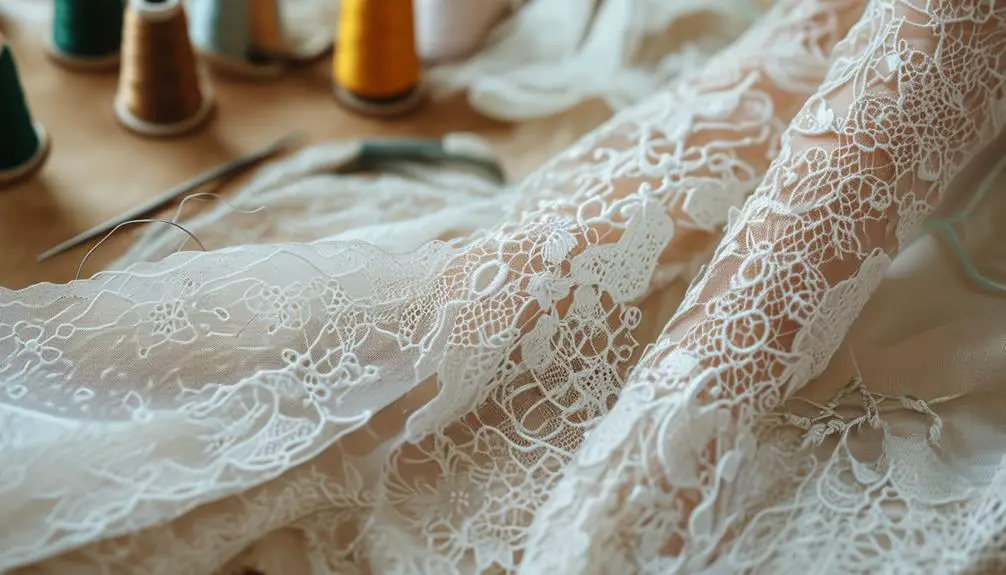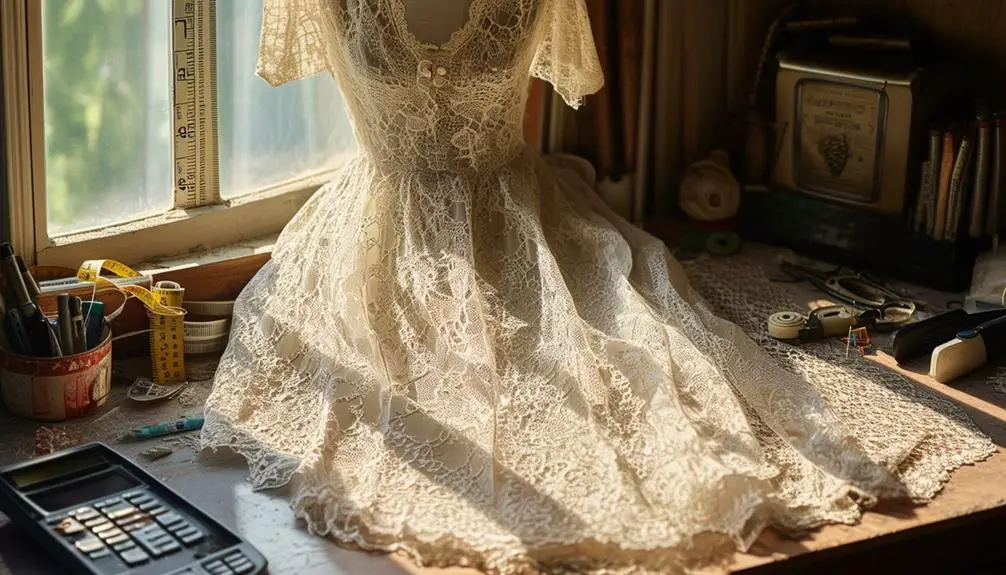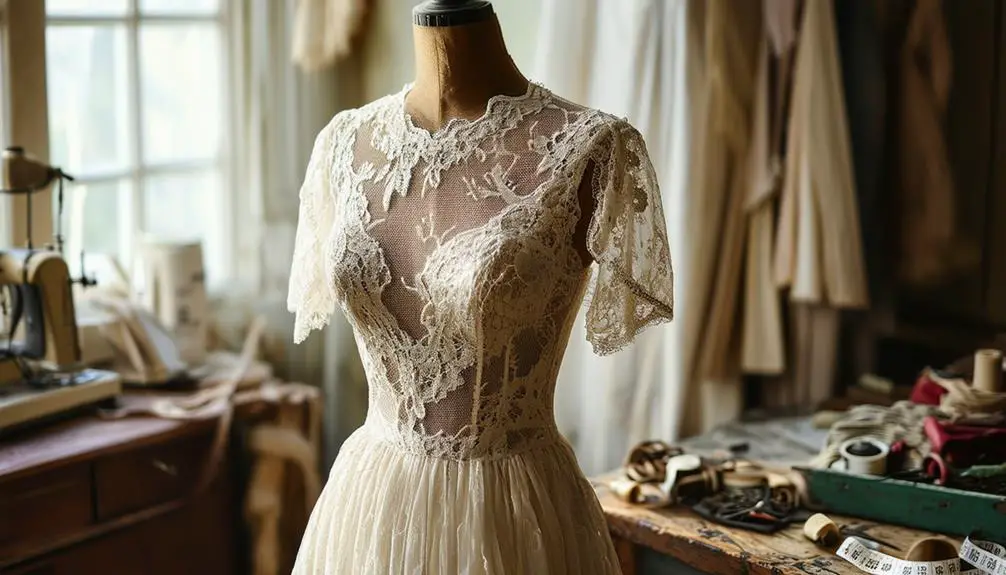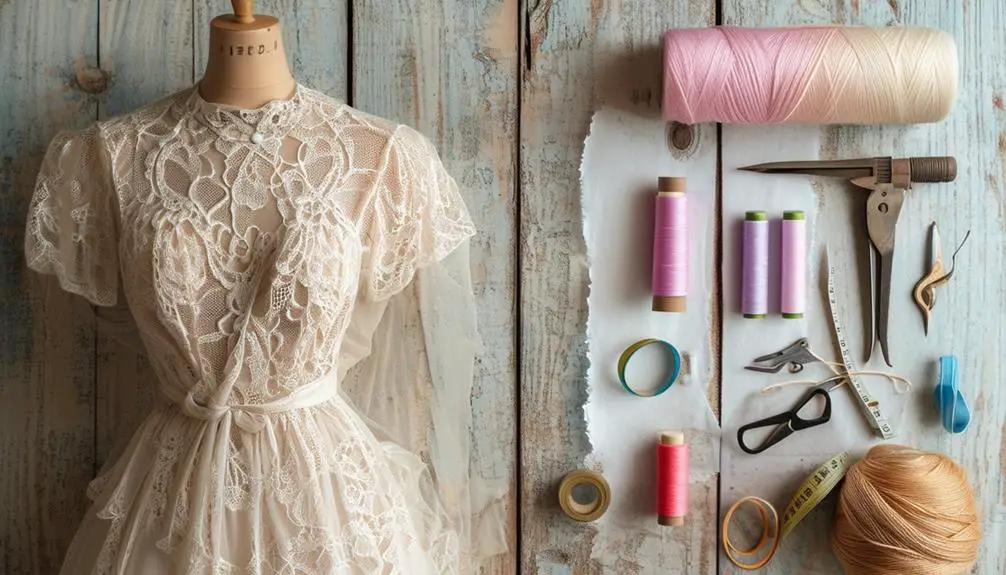To tailor a vintage lace dress, start by evaluating its structural integrity, checking for weakened armholes and neckline. Carefully repair any damaged areas with hand-stitching or bias tape to retain its charm. If the sleeves are shredded, remove them and create gathered cap sleeves using lace remnants. Don't forget to enhance your dress with decorative elements like floral appliqués to blend repairs seamlessly. Communicate your fit preferences during multiple fittings for a flawless look. Each choice you make adds character while ensuring a perfect fit. You'll find even more tips on embracing the beauty and sustainability of vintage fashion.
Assessing the Vintage Lace Dress

When you first lay eyes on a vintage lace dress, take a moment to assess its condition—this step is crucial for a successful tailoring process. Start by closely examining the structural integrity of the garment. Check areas like the armholes and neckline for any potential stress points that could lead to further damage.
Look for shredded lace or other damaged components, such as sleeves, that may need removal or replacement to prevent deterioration. Understanding the identifying vintage characteristics can also help you spot unique elements that contribute to the dress's authenticity.
Next, explore the dress's original design elements. If it features an off-shoulder neckline, consider how this might affect fit and stability during alterations on a lace dress. It's important to maintain the elegant aesthetic while ensuring a comfortable fit.
As you assess, don't overlook the intricate details. Lace motifs and scalloped edges require careful handling; they're what give full lace dresses their vintage charm.
Repairing Structural Issues
Repairing structural issues in a vintage lace dress is essential to preserving its elegance and ensuring a comfortable fit. Begin by evaluating the dress's integrity, focusing on areas like armholes and the neckline, which may show wear from enthusiastic dancing.
| Issue | Solution | Tools Needed |
|---|---|---|
| Shredded Sleeves | Remove and stabilize armholes | Scissors, Needle, Thread |
| Off-Shoulder Neckline | Angle for better fit and support | Measuring Tape, Pins |
| Weak Armhole | Hand-stitch lace remnants | Lace or Tulle, Needle |
| Zipper Area | Reshape for original fit | Seam Ripper, Sewing Machine |
If sleeves are shredded, remove them to prevent further damage. For added stability, hand-stitch lace remnants into the armholes. Reinforce the neckline and armholes with bias tape, ensuring durability. Finally, reshape the zipper area carefully, so all alterations blend seamlessly with the vintage aesthetic. With attention to detail, you can transform your lace piece into a stunning addition to your wardrobe, perfect for wedding dresses or any special occasion.
Reconstructing Sleeves

Reconstructing sleeves on a vintage lace dress can breathe new life into a cherished piece, transforming it from worn to wonderful. Start by carefully removing any shredded or damaged sleeves; this step is essential to prevent further deterioration and create a clean slate for your new design.
Using remnants from the original sleeves, you can create gathered cap sleeves that maintain the dress's vintage aesthetic while adding stability and support.
Once you've fashioned the new sleeves, it's time to focus on securing them. Utilize bias tape to attach the sleeves, ensuring a sturdy connection that enhances the durability of the armholes. This method not only reinforces the structure but also provides a neat finish to your work.
For a polished look, finalize the armholes by applying bias tape around the edges. This not only reinforces the seams but also gives the lace a refined touch.
Don't forget to incorporate multi-layered sewing techniques during the reconstruction process. These techniques will enhance stability while seamlessly blending the new sleeves with the existing lace design, resulting in a beautifully tailored vintage dress that you can cherish for years to come.
Adding Decorative Elements
While enhancing the charm of a vintage lace dress, adding decorative elements can elevate its appeal and personal touch. One of the most effective ways to do this is by cutting out floral designs from leftover lace. These unique embellishments not only enhance the dress's vintage allure but also make great use of available materials.
Additionally, you can look for inspiration from identifying vintage clothing to guarantee your modifications respect the dress's original character.
Consider hand-stitching these floral appliqués over the neckline edges. This adds aesthetic appeal while cleverly concealing any repair work done during the tailoring process.
Additionally, you can incorporate gathered cap sleeves from old sleeve remnants, restoring original design elements and providing extra stability and comfort.
Don't overlook the power of bias tape; adding it to armholes and the neckline reinforces structural integrity and acts as a decorative element that beautifully complements the lace design.
By blending repairs with decorative features, you guarantee the dress maintains its vintage beauty while adapting to modern wearability. Each of these decorative elements transforms your lace dress into a one-of-a-kind piece, showcasing your creativity and personal style.
Embrace these ideas, and let your vintage dress shine with renewed elegance.
Understanding Alteration Costs

When considering alterations for your vintage lace dress, understanding the potential costs involved is crucial to avoid any unexpected financial strain.
Alteration costs for lace dresses typically range from $350 to $700, with the average fee hovering around $400. However, if you only need basic adjustments, you might find prices as low as $135.
It's important to recognize that significant variation in costs can arise depending on the complexity of the dress design and the experience level of the seamstress.
A seasoned professional may charge more, reflecting their expertise, while local seamstresses can often provide more affordable options. Don't hesitate to shop around for quotes, as you could find a skilled tailor who fits your budget.
Keep in mind that many brides express concern over the financial aspects of necessary modifications.
By budgeting for these alteration costs, you can guarantee that your vintage lace dress not only fits beautifully but also aligns with your financial expectations.
Ultimately, being informed will help you make the best choices for your dress and your wallet.
Choosing Quality Materials
After budgeting for alterations, the next step in ensuring your vintage lace dress shines is choosing quality materials. When selecting lace, always opt for high-quality options that are soft and comfortable. Low-quality lace can irritate sensitive skin and mightn't withstand the rigors of alterations.
To make an informed choice, use fabric swatches to evaluate the texture, durability, and overall aesthetic appeal of the lace before you buy.
Pay attention to the weight and pattern of the lace, as these characteristics can greatly impact your sewing experience. Heavier laces may require additional support and careful handling, adding complexity to your alterations.
Research different types of lace like Chantilly, Alençon, or Venice to understand their unique qualities and how they fit your vintage design.
Tips for Successful Fittings

Getting the fit just right for your vintage lace dress is vital to achieving that stunning look you envision. To kick things off, schedule your first fitting at least five months before your event. This timeframe allows ample opportunity for necessary alterations, ensuring everything falls into place flawlessly.
When you meet with your seamstress, communicate your desired fit clearly. Don't hesitate to emphasize specific areas of concern, such as the bust or waist. This clarity helps her make accurate adjustments tailored just for you.
Also, remember to bring the undergarments you plan to wear on the big day. These can greatly impact the dress's fit and silhouette, so it's important to have them on hand during fittings.
If you experience any weight fluctuations, make sure to inform your seamstress at each fitting. This way, she can accommodate changes and maintain the dress's integrity.
Lastly, expect multiple fittings; intricate details like lace scallops and layered fabrics often require careful attention to achieve that perfect fit. Embrace the process, and soon you'll have a breathtaking dress that fits like a dream!
Embracing Sustainable Fashion
Sustainable fashion is more than just a trend; it's a conscious choice that can redefine your wardrobe and impact the planet positively. By embracing upcycling, you can breathe new life into vintage lace dresses, reducing waste and extending their lifespan instead of tossing them after a single wear.
Understanding the history of these garments through vintage tag identification adds depth to your creative process. Imagine the charm of a lace dress transformed by your unique touch—it's a beautiful blend of creativity and sustainability.
Repairing and altering these vintage pieces not only preserves their unique aesthetic but also supports a circular fashion economy. When you mend a tear or adjust the fit, you're not just saving a garment; you're making a statement about mindful consumption.
The RETHINK Tailoring mission encourages you to repair and reuse, promoting a sustainable mindset within the fashion industry.
Every time you choose to upcycle or repair, you're helping to mitigate the significant environmental impact of new clothing production, which contributes to around 10% of global carbon emissions.
Frequently Asked Questions
Can a Lace Dress Be Tailored?
Absolutely, you can tailor a lace dress! Just keep in mind that intricate adjustments might require a skilled seamstress. Communicate clearly about your needs to guarantee a perfect fit while preserving the dress's delicate beauty.
Can You Alter a Vintage Wedding Dress?
Yes, you can alter a vintage wedding dress, but it requires careful consideration. Consult a skilled seamstress familiar with delicate fabrics, as intricate designs may complicate alterations and affect the dress's overall beauty and fit.
Can You Hem a Lace Dress?
You can absolutely hem a lace dress, but it requires care. Use the invisible seam technique for a seamless look, and always mark your hem with a fabric-safe pen to guarantee precision and elegance.
Can Lace Dresses Be Shortened?
Yes, you can shorten lace dresses, but you'll need to be careful. Measure accurately, mark your desired length, and consider hiring an expert seamstress to preserve the intricate patterns and maintain the dress's beauty.





Your article helped me a lot, is there any more related content? Thanks!